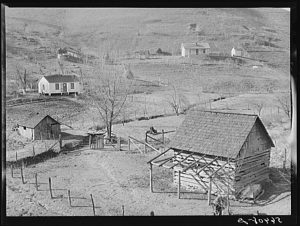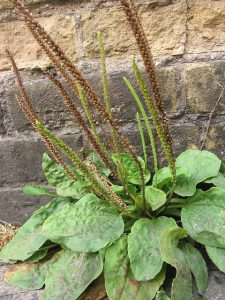When someone dedicates their life to living in the Appalachian Mountains, learning to live off the land is important. A century ago, the Hillbilly lifestyle often meant a quick doctor appointment wasn’t an option. Some communities had to travel for hours to reach the nearest health facility. Fortunately, most communities knew the mountain provides medicine, if you know where to look. Granny healers were elders with knowledge of herbs, roots, leaves, berries and bark for medicinal purposes, and many passed down their Appalachian remedies.

Appalachian town, Knox County KY, 1940, via Marion Post Wolcott http://photogrammar.yale.edu/records/index.php?record=fsa2000036943/PP
Appalachian remedies have been passed down for generations. Healers and medicine folk created what they could with materials available. Unnatural additives were not normally part of the process. Decades ago, I remember my Granny chewing on raw Ginger Root, and picking berries with her elders. As a result, we always keep fresh ginger handy, along with other traditional healing concoctions.
Fresh Ginger has a spicy flavor that can be intense if one isn’t accustomed to it. A tea with honey helps curb the spice and add sweetness. We use the tea to ease heartburn, sour stomach, and almost any stomach ache. Ginger root is an anti-inflammatory, which benefits many issues over time. A cough or cold can be relieved with ginger syrup. You likely won’t find it in stores, but many recipes have survived the test of time. Most traditionally start with grated ginger, honey, vinegar, and some spices, like cayenne. We add a little lemon to our syrup and tea.
Elderberries have unique healing properties, along with vitamins A and C. The Natives and the Appalachian people have known and used them as a sustainable healing aid for centuries. Today, variants of elderberry syrups, teas, and supplements are sold over the counter in places like Walmart. Traditionally, berries were harvested during season and prepared. The syrup would be made with love, canned, and stored for later use. Like ginger, this fruit has many uses and forms. Fresh was perfect for syrups, jams, jellies or sweets. The berry can also be dried for tea. Elderberries have been used as a number of Appalachian remedies for flu, cold, sinus issues, and minor aches. The versatile berry also makes a tasty wine… which is considered medicinal, by some.
Plantain is a green, leafy plant that you can probably find somewhere nearby. To most, it is a weed, but Natives have utilized its benefits for decades. This plant has both anti inflammatory and antibacterial properties. A poultice or salve of the leaves can help with itchy, dry skin. Plantain has been used on cuts, bites and stings to draw inflammation and heal the skin. The leaves are edible, but bitter. To balance out the flavor, mixing it with other greens and vegetables is helpful.

Plantain via John Hayes https://www.flickr.com/photos/jnthnhys/1329834064/in/photolist-7RSGWF-4A7VBS-f52iAG-32vKkw-8rVdLi-sxibKz-9PiBTE-2JD1ZJ-jgS33-6W1vUr-2Ye2vB-JCxBDH-9yb48d-4tivpm-87Qufr-aZHcCH-6S5mXG-aiYnEZ-c1gQkW-aBdYJA-ouSj-doUDR3-9y8wkJ-6reE1D-hkLqaQ-6qSsop-twvyy-k6VrYk-c
Thyme is a tasty plant that you will often find in delicious poultry, pork, and seafood dishes. This hearty herb produces white blooms and will continue to grow even during frosty weather. Appalachian residents utilized it medicinally as an antiseptic, antibiotic or antiviral. It was useful when crushed and put inside of bandages or stored in alcohol. Some folks chew the raw herb to freshen breath. Thyme has vitamins A, C and B6, so it is a beneficial part of any diet.
We’ve probably all heard the saying, “don’t pour salt on an open wound.” The mineral can burn, but it helps in the right situation. Salt is a staple in the Appalachian home, just as it is now. The condiment cures meats and seasons food, but it also has healing properties. We grew up gargling salt water for a sore throat, and soaking wounds in hot mixture to hinder infection. The right strength can usually draw out mild infections, venom, or ease sore throat pain. A tablespoon or 2 per cup of water usually did it, depending on what ailed you.

Salt via Joanna Bourne https://www.flickr.com/photos/66992990@N00/4819376578/in/photolist-8kSyKC-75s5aZ-8MCVj6-bkmYcg-7AJsd2-nrADcx-bkmYyc-4xXeeQ-218u8S-4Q7WJp-qsqFPN-3tKPv-7vjWFA-239chnp-8f4nmU-xTkvW-5SES2h-DkaGp-6r4u4i-4GGFxZ-4iVfFZ-3hjZ9-Bodcd8-cyc86w-p66BdC-SafucJ-7g4rjr-eGi
Pine trees smell great and can be used for many Appalachian remedies. The Pine’s sticky sap is almost impossible to get off clothes, but a firm consistency mixed with honey makes a nice gum. Coughs, congestion and sore throats might get relief from sap chewing. The pine needles are a good source of vitamin C, and can be boiled in a tea for similar relief. Pine has a strong flavor, but a nice dollop of honey helps coat the throat and balance the flavor.
Burdock grows wild, reaching heights of 4’ with purple blooms and prickly burrs that adhere to anything. It is healthy and edible, from the seeds to the roots. A warm drink can be made from the seeds for dysentery. A tea brewed from the roots is an excellent diuretic and relieves water retention. Burdock root is often among the ingredients of cleansing teas available in stores. Burdock is also said to have anti inflammatory properties, easing mild aches and pains over time.
The elders, Granny healers and medicine men/women all had their own special recipes using the sustainable materials around them. We just covered seven of the basic healing aids used by the Appalachian people. Though we have a deep appreciation of the old ways and traditions, we are not advising anyone to change or try any Appalachian remedies mentioned. Always consult your doctor when on medication before attempting a new regime.


Snake root and the inner bark of a sassafras tree were the go-to’s for my grannies.
Very awesome magazine